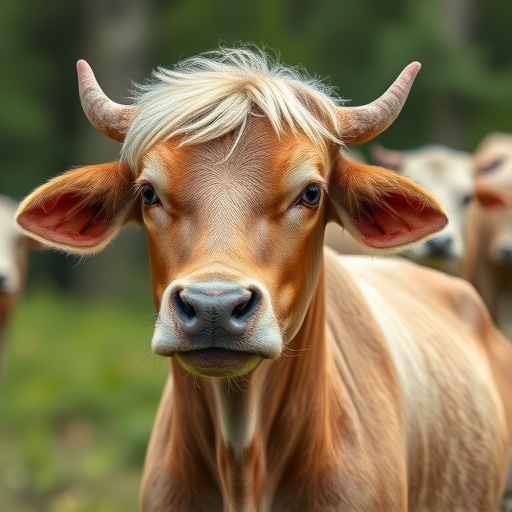Brazilian scientists have pioneered a groundbreaking methodology capable of forecasting how diverse herds of production animals will physiologically respond to the relentless pressures of climate change from 2050 through 2100. This global-scale model integrates extensive data sets and sophisticated machine learning algorithms to assess the vulnerability and adaptability of livestock under varying climate scenarios, particularly considering the anticipated rise in global temperatures.
The methodology emerges amid projections that a 2-degree Celsius increase in average temperatures by 2050 will exacerbate the severity and frequency of climate-induced stresses affecting agriculture, animal welfare, and human health. The implications are profound, mandating strategic public policies and private sector interventions to safeguard food security and sustainable production systems globally.
Through rigorous analysis, the study reveals a markedly unequal impact of climate change on small ruminants across hemispheres. Animals in the Northern Hemisphere are expected to endure a burden up to 68% greater in respiratory rate increases compared to their Southern Hemisphere counterparts under the same climate projections. This disparity underscores the need for regionally tailored adaptation strategies that account for geographical and environmental variability.
Within tropical regions, phenotypic plasticity—a biological characteristic that enables organisms to modify their physical attributes in response to environmental variations—plays a critical role in livestock resilience. For instance, while dairy cattle exhibit sensitivity to heat stress in these climates, goats and beef cattle demonstrate a more robust adaptability, underscoring the intricate interplay between genotype and phenotype in climate resilience.
Among Southern Hemisphere production animals, poultry such as laying hens and quail are identified as particularly susceptible to heat stress, with projections estimating a 40% increase in their respiratory rates by the end of this century. These findings highlight the exigency of enhancing genetic resilience and environmental control measures within poultry farming systems, which remain integral to global protein supply chains.
The research team, led by Iran José Oliveira da Silva of the University of São Paulo’s Luiz de Queiroz School of Agriculture (ESALQ-USP), emphasizes the necessity of breeding heat-resistant animal strains and refining production environments to mitigate climatic impacts. Their work accentuates the fusion of genetics and environmental management as pivotal to sustaining high-level productivity amid climatic upheavals.
The analysis extends beyond simple observation, employing an integrative approach wherein 12 international databases encompassing biological, productive, and environmental dimensions were standardized and subjected to exploratory factor analysis and multivariate regression. Importantly, machine learning techniques were harnessed to predict adaptive phenotypes across hemispheres under IPCC-RCP 4.5 climate projections, fostering a data-driven understanding of livestock resilience.
Various physiological biomarkers were scrutinized, including thermoregulatory functions such as respiratory rate and rectal temperature, hematological profiles derived from comprehensive blood analyses, and morphological characteristics. Notably, hematological variables emerged as superior indicators of thermal adaptation, emphasizing their value over external features like coat morphology in assessing animal welfare under warming conditions.
The urgency for adaptive innovation is magnified in light of the growing global population, expected to reach approximately 10 billion by 2050, as well as persistent challenges such as food insecurity affecting over 8% of the world today, and substantial food wastage representing one-third of global production. The environmental footprint of livestock, responsible for about 31% of global greenhouse gas emissions and considerable deforestation, further complicates sustainability objectives.
In this complex context, maintaining the balance between livestock productivity and resilience is paramount. Countries in the Northern Hemisphere, with their historically higher productivity, face daunting climate-related challenges, while Southern Hemisphere nations must accelerate efforts in genetic conservation, crossbreeding programs, and biomarker development to safeguard local breeds and ensure adaptive capacity.
However, the research confronts limitations tied to data availability and heterogeneity. Variances in database sizes, collection methodologies, and the scarcity of information on confined livestock systems—commonly used in nations like China and the United States—constrain the breadth of current models. Rectal temperature and respiratory rate remain the most consistently recorded variables across studies, serving as essential yet insufficient proxies for comprehensive adaptation assessment.
Looking forward, the research team aims to broaden their database by incorporating additional global datasets and expanding phenotypic profiling of birds and pigs across Brazilian regions. This continued data enrichment is expected to enhance the precision of predictive models, enabling stakeholders worldwide to devise more effective mitigation and adaptation frameworks.
The study’s implications resonate strongly with the United Nations’ Sustainable Development Goals, particularly those targeting food security, poverty eradication, and climate action by 2030. By providing a scientifically grounded framework for understanding livestock adaptability, the findings offer a vital foundation for aligning genetic conservation, production management, and environmental policy on a global scale.
With Brazil poised as one of the world’s leading meat producers, generating over 31 million tons of beef, pork, and poultry annually, the urgency to mitigate heat stress in highly sensitive groups such as dairy cattle and poultry cannot be overstated. Proactive strategies integrating genetic selection and environmental innovations are critical to preserving productivity and sustaining Brazil’s pivotal role in the global food system.
The researchers’ work exemplifies the power of international collaboration and multidisciplinary approaches in confronting the multifaceted challenges posed by climate change. By charting the path for sustainable animal production, this study stands as a clarion call for the integration of data science, genetics, and environmental stewardship to secure a resilient agricultural future.
Subject of Research: Physiological adaptability and thermoregulatory responses of livestock to climate change impacts projected for the 21st century.
Article Title: Physiological adaptability of livestock to climate change: A global model-based assessment for the 21st century
News Publication Date: 4 September 2025
Web References:
- Environmental Impact Assessment Review
- Centre for Research on the Environment (NUPEA) at ESALQ-USP
- São Paulo Research Foundation (FAPESP)
References:
- Silva, I. J. O., et al. (2025). Physiological adaptability of livestock to climate change: A global model-based assessment for the 21st century. Environmental Impact Assessment Review. DOI: 10.1016/j.eiar.2025.108061
Keywords: Livestock, Climate change adaptation, Food security, Biomarkers, Thermoregulation, Phenotypic plasticity, Hematological analysis, Sustainable agriculture, Genetic resources, Machine learning, Environmental sustainability, Animal production




